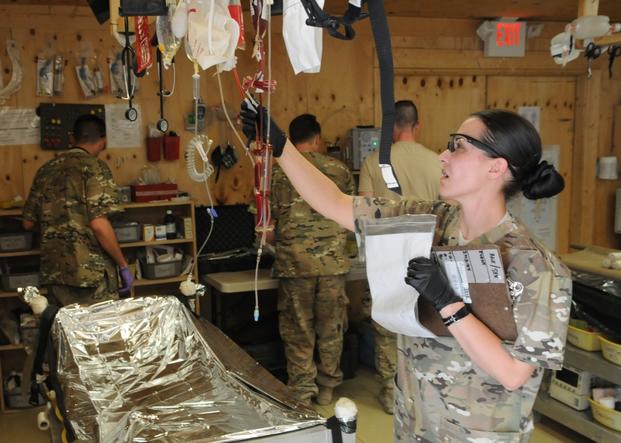BROOKE ARMY MEDICAL CENTER, Texas -- Researchers, doctors and biotechnicians at the U.S. Army Institute of Surgical Research are working on a new, more efficient way to administer blood to troops in a heavy trauma situation.
One possibility? Powdered blood.
Researchers are looking at, "How do we replicate the red blood cell?" said Brig. Gen. Jeffrey Johnson, commanding general of Brooke Army Medical Center in San Antonio, which sits adjacent to the research facility.
During Defense Secretary Ash Carter's Nov. 16 tour of the hospital, Johnson spoke with Military.com about the latest medical technologies the institute is cultivating "because on the battlefield, that's a big issue for us."
It's complicated to keep blood, "at the right temperature, in the right volume, make sure it can still store oxygen when you put it into somebody," Johnson said. As a result, researchers are trying to develop an artificial blood product.
"We're looking at powder products that get reconstituted [as liquid]," he said. It would save the exhaustive measures required to keep whole blood viable while in remote areas or on the battlefield.
Skin in a Spray Bottle
Johnson said the institute is also looking at ways to patch up burn victims on site.
"They're developing artificial skin, or skin that comes from just a very small piece of a person's skin, and then can be made into a large amount, and then be put into a spray bottle," he said. The flesh mist would regenerate and grow as it is applied to the surface of the body.
New breakthroughs will also help drive how doctors can operate or respond to trauma without the tools provided in an operating room.
Brooke Army Medical Center wants its doctors and technicians to be able to "make critical decisions in that austere environment," Johnson said.
The 425-bed facility has more than 8,800 employees. Johnson said the staff breakdown is roughly 20 percent soldiers, 20 percent airmen, 20 percent contractors and 40 percent civilians.
At any given time, there are about 600 residents and fellows, military and nonmilitary, training in the latest medical practices and skill sets. The facility has 900 medical students on an annual basis, and 1,200 medical technicians "who receive all of their clinical exposure here in this facility as well," Johnson said.
It all "really drives us to the center of our mission, which is figuring out, 'How do we generate readiness either in trainees, or in our staff, to be able to deploy tonight, or to take care of an extensively wounded service member from downrange who arrives here tonight?' " he said.
Some of that also applies to outpatient care.
Prosthetic Advances
A practice "for years" at Brooke has been to forgo buying off-the-shelf prosthetics. Instead everything is engineered at the facility to individualize the end product.
"So what we're buying is a nut, bolt, hinge, and then we're turning it into some of those prosthetics such as a [walkable] spring, or a flipper if you want to swim, a running shoe, whatever," Johnson said.
Brooke has advanced its prosthetics technology over the last 15 years. In 2009, for example, its Center for the Intrepid for rehabilitation created the Intrepid Dynamic Exoskeletal Orthosis, or IDEO, a lightweight, hydraulic assist, carbon-fiber device that "increases mobility and decreases pain for wounded service members with lower leg injuries," according to a release.
Johnson said that product has now been commercialized.
"The cool thing is, the soldiers that needed that kind of device were chaptered out of the military," he said, "but now, 60 percent of them have returned back to their unit[s]."








